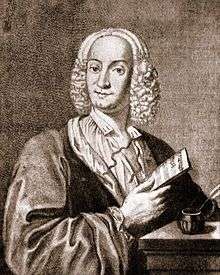Concerto alla rustica
The Concerto for Strings in G major, RV 151, commonly referred to as the Concerto alla rustica (Italian for '"rustic concerto"'),[1] is a concerto for orchestra without soloists by Antonio Vivaldi. It was written between mid-1720 and 1730, and is one of the composer's best-known concertos.
| |
|---|---|
| by Antonio Vivaldi | |
 The composer | |
| Key | G major |
| Catalogue | RV 151 |
| Genre | Late Baroque |
| Form | Concerto |
| Composed | Between mid-1720 and 1730 |
| Movements | 3 |
| Scoring | String orchestra and basso continuo, with two oboes in the finale |
Composition
The Concerto alla rustica, unlike some other of Vivaldi's concertos, did not include a descriptive programme.[2] It was composed some time between mid-1720, and 1730, during which time Vivaldi was working on his Contest Between Harmony and Invention, Op. 8—the work from which his best-known set of compositions, The Four Seasons, derive.[3]
The manuscript of this concerto was written partially on the same paper as his chamber version of the Goldfinch Concerto, Il Gardellino, RV 90b. The musicologist Michael Talbot has said that since that concerto was supplied to the court of the Ottoboni family in Rome, it is likely that the Concerto alla rustica was as well.[4]
Structure
The concerto is in three movements and typically takes between 5 and 6 minutes to perform. It is scored for a string orchestra and basso continuo, and includes two oboes in its final movement. The movements are as follows:
- Presto
- Adagio
- Allegro
The first movement is a moto perpetuo—a virtuoso piece for a Baroque orchestra in G major. It veers to G minor towards the final bars of the movement. The second movement is slow and contrasting, with long chords. The third movement is dance-like and swift. This last movement emphasizes the sharpened fourth degree of the scale (C sharp), therefore using a Lydian mode—a trait common to folk music. This feature was probably known to Vivaldi thanks to the Polish-style sonatas and concertos of his contemporary Georg Philipp Telemann.[5]
Use in popular culture
The Concerto alla rustica, which is among Vivaldi's best known concertos, has been featured in a number of films and TV series, among them:
- All That Jazz by Bob Fosse (1979)
- Gramps Is in the Resistance by Jean-Marie Poiré (1983)
- El Aura by Fabián Bielinsky (2005)[6]
- Marie Antoinette by Sofia Coppola (2006)
- Mijo (2015), the second episode of the television series Better Call Saul, created by Vince Gilligan.[7]
- Freaky Tuesday, Season 3 Episode 5 of GLOW opens with a riff on the "It's Showtime, Folks!" montage in All That Jazz
References
- "Antonio Vivaldi (1678 – 1741)". Music Files Ltd. Retrieved 31 March 2015.
- "About this Recording 8.550056 - VIVALDI: 4 Seasons (The) / Concerto alla Rustica (Liner Notes of Naxos 8.550056)". naxos.com. Naxos Digital Services. Retrieved 31 March 2015.
- "ANTONIO LUCIO VIVALDI (1678-1741)". Retrieved 31 March 2015.
- Talbot, Michael. "Vivaldi: Cantatas, Concertos & Magnificat (Liner Notes of Hyperion Records 55190)" (PDF). Hyperion Records. Retrieved 31 March 2015.
- Malone, Andrew Lindemann. "Antonio Vivaldi Concerto alla rustica, for strings & continuo in G major, RV 151". allmusic.com. Rovi Corporation. Retrieved 31 March 2015.
- "El aura (2005) Soundtracks". imdb.com. IMDb.com. Retrieved 31 March 2015.
- "Better call Saul (TV Series) Mijo (2015) Soundtracks". imdb.com. IMDb.com. Retrieved 31 March 2015.